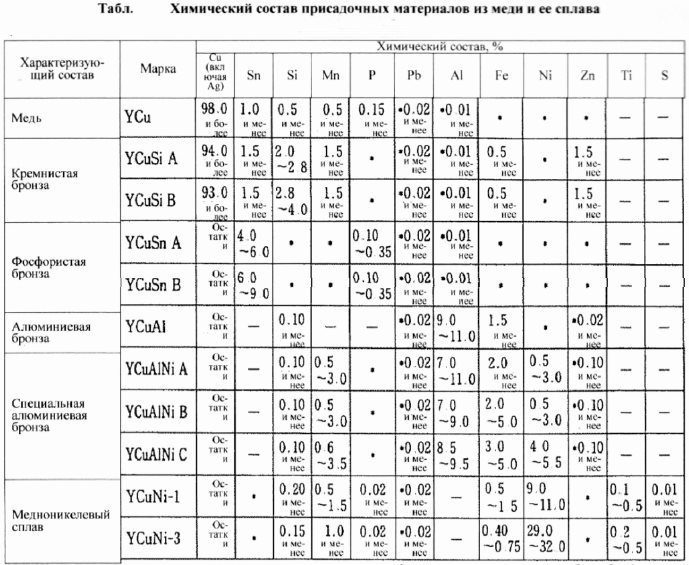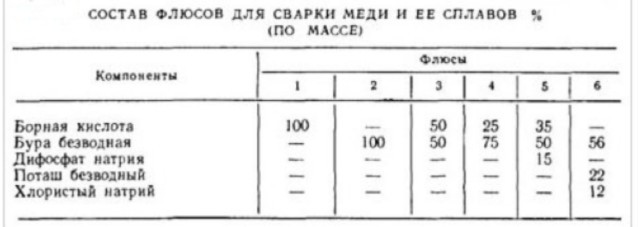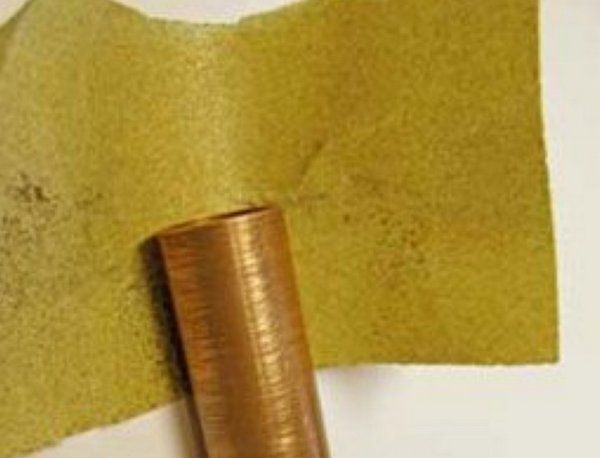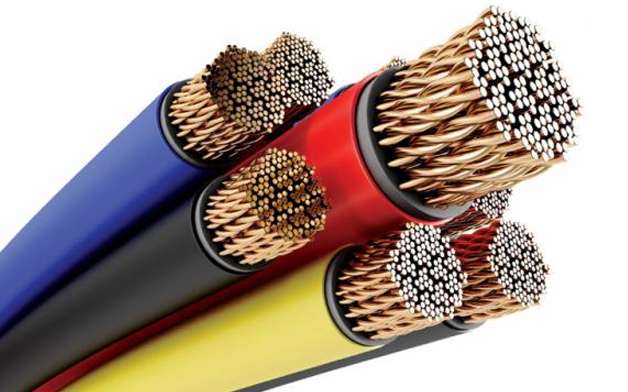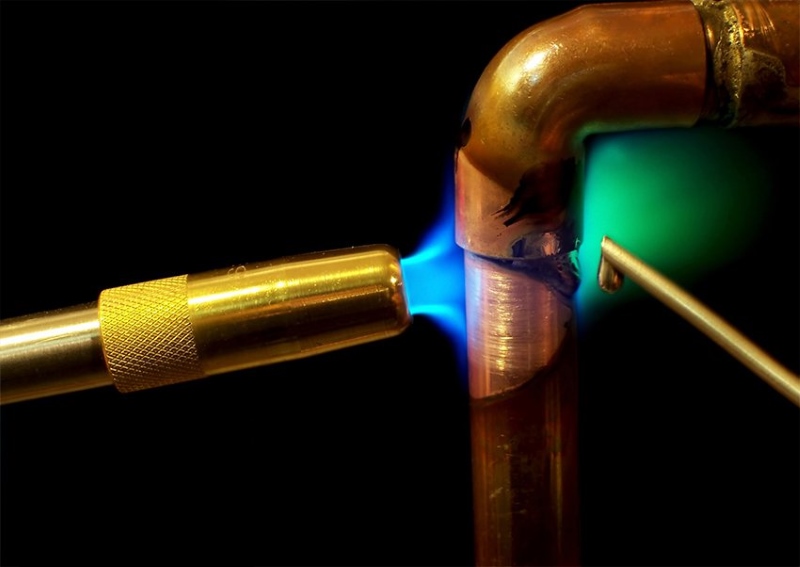Copper welding methods
The negative properties of copper that prevent welding are bypassed in many ways, using various consumables and equipment. Not all can be applied at home, but some are quite affordable.
Welding of copper with argon
In this way, copper is welded by a semi-automatic or manual argon-arc method. The work is carried out with direct current of direct polarity. Its value is set on the basis that 100 A is needed for each millimeter of thickness. The value can be adjusted during operation, depending on the composition of the metal. When welding copper with argon, the gas flow rate should not exceed 10 l/min.
As a filler wire, you can use copper wires or cable cores, cleaned of insulation and varnish. It is fed along the edge of the weld pool in front of the electrode so that the metal does not stick to it during melting. For workpieces with a thickness of less than 0.5 cm, preheating is not required.
Most often, copper is welded with carbon electrodes, since tungsten electrodes often have to be changed. Billets with a thickness of more than 1.5 cm are connected with graphite electrodes. Permissible overhang of the electrode is not more than 7 mm, the length of the arc is 3 mm. Unlike other methods, welding of copper with argon can qualitatively connect vertical joints.
https://youtube.com/watch?v=CCtzoyyn120
Gas welding
This technology does not require sophisticated equipment as for argon-arc technology. A torch and a bottle of acetylene are enough. To ensure the normal flow of the process, a gas flow rate of 150 l / h is required for workpieces up to 10 mm thick, more than 200 l / h. To slow down the cooling of the workpiece, they are covered with sheet asbestos on both sides. The diameter of the filler wire is chosen equal to 0.6 of the metal thickness, but not more than 8 mm.
When gas welding copper, the flame is directed perpendicular to the joint. In this case, it is necessary to ensure that the wire melts before the base metal. To reduce the likelihood of hot cracks, work is carried out without stopping. The completed joint is forged without heating if the parts are thinner than 5 mm, or at a temperature of 250⁰C when they are thicker. Then annealing is carried out at 500⁰C and rapidly cooled with water.
Manual arc welding
In this way, workpieces with a thickness of more than 2 mm are connected using consumable electrodes and direct current of reverse polarity. The process practically does not differ from steel welding, only the electrode is carried out without transverse oscillations, maintaining a short arc. The seam is formed by reciprocating movements.
For welding copper at home, the ANC-1 electrodes are recognized as the best, which can be used to join metal up to 15 mm thick without heating. Polish-made EC and EG brands have similar characteristics. When repairing a pipe with a hot carrier, it should be taken into account that the heat and electrical conductivity of the seams made by this method are 5 times less than that of copper.
The current strength and electrode diameter depending on the thickness of the parts are given in the table:
|
Copper thickness, mm |
Electrode diameter, mm |
Current value, A |
|
2 |
2 — 3 |
100 — 120 |
|
3 |
3 — 4 |
120 — 160 |
|
4 |
4 — 5 |
160 — 200 |
|
5 |
5 — 6 |
240 — 300 |
|
6 |
5 — 7 |
260 — 340 |
|
7 — 8 |
6 — 7 |
380 — 400 |
|
9 — 10 |
7 — 8 |
400 — 420 |
Automatic submerged arc welding
To work, you will need a welding machine that produces alternating and direct current. The flux is applied to both sides of the joined workpieces. Welding under ceramic flux is carried out with alternating current, for the rest, reverse polarity is established. To connect parts thinner than 10 mm, ordinary fluxes are used. Thicker blanks are cooked under dry granular ones.
Welding is carried out in one pass using a copper filler wire. If the characteristics of thermal and electrical conductivity are not important, it is replaced with bronze to increase the strength of the connection.In order for the seams to be created simultaneously on both sides, flux pillows are laid out on the linings under the joint.
When working with copper and its alloys, toxic gases are released. Zinc evaporates from brass with strong heating, forming a poisonous oxide. Therefore, it is necessary to work in respirators and protective clothing in rooms with exhaust ventilation.
Preparation of parts for welding
Regardless of the method, copper blanks must be cleaned of dirt, followed by degreasing. The oxide film is removed with a metal brush or fine-grained sandpaper with careful movements so that there are no deep scratches. Cleaning is recommended to be completed by pickling the parts to be welded and the wire in an aqueous solution of nitric, hydrochloric or sulfuric acid. Then rinse with fresh water and dry with hot air.
From the edges of the workpieces with a thickness of 0.6 - 1.2 cm, chamfers are removed so that an angle of 60 - 70⁰ is obtained between them. When welding on both sides, it is reduced to 50⁰. If the thickness of the parts is more than 12 mm, the edges are cut in the form of the letter X for two-way connection. If this is not possible, make a deep V-cut. But to fill the joint, more consumables and time will be required, since copper will have to be welded with a wide seam.
To prevent deformations during shrinkage between the blanks, depending on the thickness, a gap of 0.5 - 2 mm is left. To keep its width unchanged along the length of the joint, the parts are seized at intervals of 30 cm. When the seam is brought to a temporary joint, it is knocked down with a hammer, otherwise the joint will be defective at this place.
To prevent copper from flowing to the reverse side, plates of steel or graphite 4–5 cm wide are placed under the joint. To compensate for thermal expansion, the parts are preheated to 300–400⁰C. When working outdoors, you will need portable screens that protect from the wind.
Copper welding
Copper materials are used in conditions with increased requirements for ductility and corrosion resistance.
Welding of copper is carried out using various areas of production, decorative parts due to the increased aesthetic properties.
The thermal conductivity of the material is two times higher than aluminum alloys, there are many ways to join copper products. Modern technologies make it possible to avoid hot cracks, porous formations and other non-compliance with standards during operation.
Copper welding
Welding of copper and its alloys technology
Copper alloys, in contrast to the pure type of metal, have a reduced thermal conductivity, as a result of which an elevated temperature is not required.
There are several types of alloys, the best option is oxygen-free copper. Copper welding technology involves the use of pre-prepared products.
Before welding, parts of the appropriate size are made, for components up to 18 mm long, chamfer edges are prepared.
In high volume operations, processing speed is achieved by using a beveler that is able to machine the part into the desired shape.
In addition, the joints are thoroughly cleaned of dirt and oxidation, in order to avoid the formation of defects. Welding of copper takes place in an environment protected from oxygen; for this, aluminum alloy wire with the addition of phosphorus is used.
The part cleaned of impurities requires preheating, otherwise the flux layer will spread unevenly along the seams.
arc welding
High-quality production is carried out using electrodes, the arc length is not more than 5 mm. The connection of the pulse-arc method allows you to produce various seams, use thin metal. In difficult situations, in order to avoid fracture and the formation of cracks, an emphasis is placed, which contributes to the reliable fastening of parts.
How to cook copper ways
Obtaining a guaranteed connection occurs by using various methods of joining nodes. Used for joining:
- gas apparatus;
- inverter;
- semi-automatic;
- tool for manual arc welding.
The connection is made with consumable and non-consumable wire electrodes, in automatic or manual mode using flux. When working with materials of large diameter, the electroslag method is used.
Copper gas welding
The inverter connection method implies the presence of a high-quality metal melting device. A wide range of products is presented at the construction trade rows, allowing you to choose a tool for the appropriate site. Among others, it is worth noting graphite electrodes, which allow crafts to be made at different temperature conditions.
Welding difficulties
It is necessary to follow the recommendations of the masters, because. metal differs in characteristics from other components. The main difficulties and points that arise in the process:
- Liquid fluidity complicates the connection of seams in a vertical position. In the lower position, welding is carried out using a spacer, vertical works are available in short-term mode.
- A high degree of thermal conductivity of the material will require the use of methods for removing heat from the docking zone.
- Linear expansion during heating affects the increased tendency to deformation, the formation of cracks.
You should also remember about the ability to absorb oxygen and hydrogen when exposed to high temperatures. The tendency to oxidize requires the use of special gels consisting of silicon, phosphorus or manganese.
, please select a piece of text and press Ctrl+Enter.
Difficulties in fusion welding of aluminum and copper products
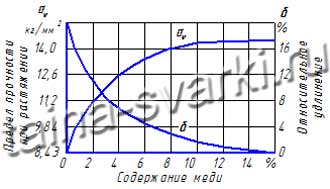
copper with aluminum is quite difficult to produce by fusion welding.
This happens due to the fact that the composition of the molten metal is regulated practically
impossible, and the mechanical properties of the welded joint strongly depend on the content
there is copper in it, this is clearly visible from the diagram (see the figure on the left).
If copper-aluminum alloy copper content exceeds 12%, then the tensile strength
ceases to increase under tension, and the viscosity of the alloy and its corrosion
durability drops sharply. Therefore, when the copper content in the weld metal
more than 12%, the joint becomes very brittle and prone to
crack formation after welding.
Practical research on welding aluminum and copper using coal
electrode did not give positive results. Join copper and aluminum
the help of fusion welding is possible if it melts, it will mainly
aluminum. Often used, the so-called "castle" connection,
where possible.
"Castle" connection of aluminum and copper
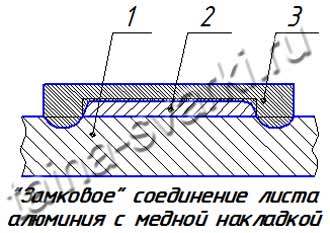
"Castle" connection (see figure on the left) is as follows. On the
sheet of aluminum, pos.1 impose a copper pad pos.2 and scald it on
the entire perimeter with a welded seam, flush with the overlay. Next, surfacing
pos.3, which connects the welds deposited around the perimeter of the copper lining.
Thus, something like an aluminum alloy lock is learned. Welding process
must be produced with forming graphite strips.
Aluminum and copper welding modes
The modes of welding aluminum with copper are very similar to
aluminum welding modes. The nature of the welding current - direct, direct
polarity. Cast iron rods are used as filler material.
aluminum with a diameter of 12-20mm for the thickness of aluminum 29-30mm and copper 10mm. Welding force
current 500-550A. The voltage of the electric arc is 50-60V, and its length is 20-25mm. For
welding, graphite electrodes with a diameter of 15-20 mm are selected.
Features of copper welding
The process of working with copper products largely depends on the presence of various impurities (lead, sulfur, etc.) in its composition. The smaller the percentage of such impurities will be contained in the metal, the better it will be welded.When working with copper, it is necessary to take into account the following features:
- Increased oxidation. During heat treatment of this metal with oxygen, cracks and brittle zones appear in the near-weld zone.
- Absorption of gases in the molten state of copper leads to the formation of a poor-quality weld. For example, hydrogen, combining with oxygen during metal crystallization, forms water vapor, as a result of which cracks and pores appear in the heat treatment zone, which reduce the reliability of the weld.
- Great thermal conductivity. This property of copper leads to the fact that its welding must be carried out using a heating source of increased power and with a high concentration of thermal energy in the area of the weld. Due to the rapid loss of heat, the quality of the formation of the seam decreases and the possibility of formation of sagging, undercuts, etc. in it increases.
- A large coefficient of linear expansion causes significant shrinkage of the metal during solidification, as a result of which hot cracks can form.
- As the temperature rises above 190°C, the strength and ductility of copper decrease. In other metals, as the temperature rises, a decrease in strength occurs with a simultaneous increase in ductility. At temperatures from 240 to 540°C, the ductility of copper reaches its lowest value, as a result of which cracks can form on its surface.
- High fluidity makes it impossible to carry out high-quality one-sided welding on weight. To do this, you need to additionally use gaskets on the back.
Features of copper welding by argon-arc method
Copper itself, as well as alloys based on it, are sufficiently highly thermally conductive materials, which, among other things, also have high electrical conductivity, as well as high corrosion resistance both under the influence of external factors and relative to intracrystalline corrosion.
The melting point of copper in its pure form is 1083 ° C, and in the case of the addition of various alloying chemical compounds, this indicator may shift to one side or the other.
Welding is most often carried out using the argon-arc method by using a non-consumable electrode with direct current. A rod made of pure copper or its alloys is used as filler material. This allows you to achieve maximum quality of the seam, as well as its neat appearance.
If the materials are chosen incorrectly, the copper in the weld pool begins to boil, which causes the formation of a large number of pores in the resulting seam, and the joint itself becomes brittle and may collapse during operation.
Distinctive features of copper
Copper is able to conduct heat six times more than regular iron. Because of this, welding must be carried out with increased thermal energy, and in some cases even preheating of the base metal is possible.
Under normal conditions, copper is inert, but in the process of heating it reacts with oxygen, hydrogen, phosphorus and sulfur. Oxygen is able to oxidize copper at high temperatures, and above 900 ° C, the oxidation rate increases significantly. This is due to the fact that the original composition of copper contains oxygen in a bound state. Copper oxide forms a eutectic with a lower melting point (1065 °C). The melting point of copper is 1085 °C. Therefore, the oxygen that is contained in it worsens its positive indicators.
Technology of copper welding by argon-arc method
From a technological point of view, argon-arc welding of copper, like other types of welding, is divided into three stages:
- preparatory. At this stage, it is necessary to clean the surfaces to be welded from oxides, dirt, and degrease.After performing these works, check them for cleanliness and condition and, if necessary, clean them manually or with a power tool, and then repeat the process of cleaning from oxides and degreasing;
- actual stage of welding;
- the final stage, at which the quality of the welded joint is checked after stripping from solidified drops of molten metal, as well as visual quality control of the weld for visible pores.
At the stage of actual welding, the following steps should be performed:
- if we are talking about the repair of any copper product, it is necessary to make a cut along the crack that has arisen so that the edges of such a cut go beyond the crack. This will make it possible to avoid the appearance of new cracks outside the repaired area;
- the arc is ignited only in the edge section, which will avoid burns of the metal from which the entire product is made, and will reduce the cleaned areas;
- the filler wire or rod must be led in front of the torch so that they are evenly fed into the weld pool;
- the movements of the welding torch should be as smooth as possible and maintain a constant distance from the tungsten electrode to the weld pool;
- Depending on the thickness of the parts to be welded, the torch can move along the created seam in various ways: in a straight line, if the thickness of the parts is small, or in a zigzag pattern, if the parts are thick. If transverse movements are made, this is fraught with an increase in the depth of penetration of the edges and changes in the formation of the weld;
- if thin-walled parts are welded, then in order to avoid metal burns, it is necessary to make the seams short, and between them to take breaks in time for the metal to cool;
- if the parts are assembled without a gap, it is possible to weld without using wire or rod. However, in this case, you should not overheat the metal in order to avoid subsidence of the weld pool inward;
- at the end of welding, it is necessary to retract the torch smoothly, lengthening the welding arc, which will reduce the weld crater;
- if the device has the function of welding the seam crater, then it is possible to simplify the process of finishing welding work;
- after welding is completed, it is necessary to maintain the supply of shielding gas for some time (up to thirty seconds). This will keep the cooling weld in a cloud of gas shielding and avoid the ingress of ambient air products into the molten metal, which will preserve the quality of the weld.
Difficulties of welding copper with stainless steel
The presence of hydrogen and its release to the atmosphere has an impact on the final result of welding with stainless steel. It can cause copper porosity and subsequently form a crack in the weld. The solubility of hydrogen depends on the temperature and partial pressure in the atmosphere of protective gases. During crystallization, hydrogen in copper dissolves twice as fast as in other iron.
Sulfur in copper is present up to 0.1%, it dissolves in liquid form, but is insoluble in solid copper. It has no significant effect on the quality of welding.
Due to the properties listed above, there are certain difficulties in welding copper to stainless steel:
- different chemical composition. Hydrogen and oxygen present in copper can significantly reduce the quality of the weld.
- Different coefficients of thermal conductivity (in stainless steel it is much lower).
- Different temperature conditions of melting: stainless steel melts at 1800 °C, and copper at 1085 °C, actively reacting with atmospheric gases.
- The dissolution coefficient of copper in stainless steel has a maximum of 0.4%.
- During the formation of a weld between steel and copper, a sharp boundary is formed due to supersaturation of inclusions from steel.
- There is a possibility of formation of a layer with microcracks in the steel, which will be filled with copper.To avoid this, it is necessary to move the welding arc slightly onto the copper part: in this way, copper melt is fed into the weld area.
It is easier to weld stainless steel with pure copper than with additional inclusions. Such a composition without impurities is less common, therefore the choice of the welding method and the basic technology of the welding process is the same as for other non-ferrous metals.
General characteristics of copper alloys
Pure copper is quite rare. This is due to several reasons. Firstly, such material has a high cost, and secondly, it is characterized by insufficient strength. The main copper alloys that exist today are:
- bronzes;
- Brass.
Brass is an alloy of copper and zinc. In addition, additional components (nickel, silicon, etc.) can be added to such alloys to improve strength characteristics and resistance to chemicals.
Bronzes are metals that are obtained by mixing copper with tin, aluminum, silicon and other components, if zinc is not an alloying element. There are two main groups of this alloy:
- Tin;
- Special ones that contain chromium, aluminum, nickel, beryllium, cadmium, manganese as impurities.
A bit of theory
Copper and its alloy (bronze and nickel) are used in many industries due to electrical and thermal conductivity, anti-corrosion. The melting point of the material is 1083°C. The thermal conductivity of pure copper is 2 times higher than that of aluminum, therefore, when welding with argon, a good heating of the metal is necessary.
Copper and alloys are divided into several grades. To obtain a high-quality welded joint, it is better to use deoxidized or oxygen-free copper, they have little oxygen.
The main filler compositions for welding copper with argon are presented in the table.
But in practice, similar metals in composition are usually used (which can be found in a home workshop).
Also, for better melting and fusion of metal, rods with a thin coating of the flux layer are used.
Material preparation (cleaning)
Welding of copper with argon cannot be carried out without thorough cleaning of the material. Any abrasive tool is taken and the welded area is cleaned to a shine. Further, with the help of any solvent, the material is degreased.
Material preparation is an important procedure
Take a responsible approach to cleaning copper products - this affects the quality of the connection.
To avoid defects (non-melting, slag inclusions), preheat the material to a temperature of 350-600°C. The temperature difference depends on the base metal, filler and groove. Determined by experience.
Video: how to prepare a crack at a gas copper radiator for welding.
Argon welding (TIG mode)
This technology, according to the assurances of welders, is the best, the seams are neat and durable. Welding of copper with argon is carried out with a direct current tungsten electrode. But, with an alloy of aluminum bronze, it is better to make a connection on alternating current.
The current settings of the device are selected depending on the thickness of the product and the diameter of the electrode. Table to help:
In addition to argon, nitrogen, helium and their mixtures can be used in the composition of protective gases. All of these gases have their pros and cons. But argon is still more in demand for welding.
Filler rods are selected according to the composition of the material. But usually, in a home workshop, copper wires are used, extracted from electrical cables or a transformer. Previously, the copper vein is cleaned of varnish with sandpaper and degreased with a solvent.
It is good if the extracted filler wire will have a lower melting point than the product prepared for welding.
Some tips from seasoned welders:
- always lead the additive in front of the burner;
- Argon welding for thick copper can be performed without filler wire;
- the burner is recommended to be driven in zigzags to ensure better adhesion of the metal;
- thin material, so that there are no burns, it is necessary to cook with short seams with interruptions;
- if the device does not have the “crater filling” function, then the burner must be retracted gradually (lengthening the arc);
- argon welding is performed in the vertical and horizontal position of the seam.
Video: heating and joining copper.
Copper pipe welding
When connecting copper pipes with argon, the current is set to a small value. Welding is carried out slowly, in separate pieces of the seam, with an overlap of at least 1/3. The filler wire is pushed aside by the lateral movements of the torch. The principle is simple:
- drip - stretch;
- again add and stretch.
The best option is to have a machine with a pulse welding function. The current can be set more so that the filler material melts quickly. Adjust the time between pulses so that the copper has time to cool down after the pulse is applied (burn protection). Also correctly set the time of the function - "crater filling".
P.S. Welding copper pipes or flat products for each material requires the selection of current by poking. It is desirable to carry out tests on materials similar in composition. No need to spoil the part that you decided to weld.
A correctly selected current should provide good heating and penetration of a copper product. Holes and pores should not be. Good luck with the technology!
Copper materials are used in conditions with increased requirements for ductility and corrosion resistance. Welding of copper is carried out using various areas of production, decorative parts due to the increased aesthetic properties. The thermal conductivity of the material is two times higher than aluminum alloys, there are many ways to join copper products. Modern technologies make it possible to avoid hot cracks, porous formations and other non-compliance with standards during operation.
Contact welding of aluminum and copper
Contact welding of aluminum-copper joints is successfully used in the electrical industry
for welding aluminum busbars with copper lugs, and aluminum wires with
copper tips. Capacitor is widely used in the cable industry.
welding of aluminum and copper wires according to the modes indicated in the table below:
| Welded wire diameter, mm | Capacitor capacity, microfarad | Capacitor voltage, V | Distance between parts, mm | Upset force, N |
| 2,5 | 256 | 1100 | 14 | 1471 |
| 2,8 | 256 | 1400 | 10 | 1471 |
| 2,8 | 260 | 1400 | 15 | 1471 |
| 2,8 | 380 | 1350 | 15 | 1569 |
| 2,8 | 550 | 1200 | 15 | 1716 |
| 3,5 | 550 | 1500 | 12 | 1569 |
| 5,0 | 1000 | 1500 | 14 | 1716 |
Flash butt welding of aluminum and copper tubes
Joint welding of aluminum and copper pipes is used mainly in refrigeration
industry. In this case, one should take into account the fact that during the welding process, aluminum
melts much more than copper, so the set length of the aluminum
tubes must be longer than the required length, taking into account the allowance for reflow.
To reduce the amount of burrs on the inner sides of the tubes, it is recommended in
during welding, blow the tube with nitrogen at a pressure of about 0.25 atm. Air
it is not advisable to use for this purpose, tk. the oxygen it contains
contributes to the oxidation of the metal.
Before starting butt welding, the tubes on a special device are upset
for a length of 10 mm with a thickening of the walls. This approach is necessary in order to
when processing the joint, obtain the previous hole diameter, because it was distorted
during settlement at the time of welding.
Joint processing consists in turning a thickened surface on a turning
machine and reaming the tube hole. For welding copper and aluminum
tubes with a diameter of 10-30mm and a wall thickness of 1.5-4mm, the following are recommended
welding modes:
| Specific precipitation pressure, MN/m2 | 196-216 |
| Precipitation current density, A/mm2 | 500 |
| Current density during reflow, A/mm2 | 240 |
| Average melting speed, mm/s | 12-15 |
| Settling speed, mm/s | 100-120 |
| Aluminum tube melting value, mm | 8-10 |
| The amount of payment for a copper tube, mm | 2-8 |
| Total amount of draft, mm | 3,5-5 |
| Welding time, s | 1,1-1,2 |
In the fracture of the joint, one can observe the inclusion of aluminum particles in copper. Inclusions
Copper does not turn into aluminum.
Additional related materials:
|
Welding |
Gas bronze weldingContact copper weldingWelding nickel and nickel alloysWelding aluminum and its alloys |
Bonding by arc welding
To obtain high-quality seams, electric welding is often used in production and at home. Works are carried out using carbon, fireproof tungsten and molybdenum, copper or bronze electrodes. To protect against the formation of cuprous oxide, a special flux or coating is used, which, under the influence of high temperature, forms a protective atmosphere.
General features of the work:
Welding copper products requires more current than when working with steel.
- use a greater current than when working with steel;
- pre-cleaning the edges to a metallic sheen or etching them with nitric acid, followed by rinsing with water;
- the parts are connected tightly so that gaps do not form;
- the edges open at 90 °;
- the edges of the sheets, the thickness of which is from 1 to 3 mm, are beaded, the filler wire is not used;
- with a thickness of more than 6 mm, the parts are heated to 300-400 ° C before welding;
- after work, the seams and transition zones are forged, and metal up to 6 mm is forged cold, thicker - when heated to 200-300 ° C, it is impossible to heat it higher, since the metal becomes brittle;
- the parts are then annealed by heating to 550-600°C and then rapidly cooling in cold water.
Application of carbon electrodes
Working mode:
A direct current of direct polarity is used, the voltage of which is 40-55 V, the arc during cooking should be 10-15 mm. Welding is carried out without delay as quickly as possible, using wire made of pure (electrolytic) copper or bronze containing an admixture of phosphorus. The slope of the electrode should be 70-80 °, the bar - 30 °. The additive must not be lowered into the weld pool, it must be kept between the electrodes and the parts so that the molten copper drips into the seam.
Composition of protective fluxes
Use of metal electrodes
Electrodes for welding are used from copper or bronze.
For welding copper and its alloys, electrodes made of copper or bronze are used, which are coated with a deoxidizer.
In order for the reverse side of the seam to form better, welding is performed on a copper lining. The thickness of the sheets with this method should be no more than 4 mm. It is also necessary to carefully monitor that the distance between the lining and the parts is no more than half a millimeter.
It is easier to weld parts by pouring under the seam into the lining groove the same deoxidizer from which the electrode coating is made.
Working mode
When cooking, the same fluxes are used as when cooking by the electric arc method. Flux #4 is used with wire that does not contain deoxidizers.
A more advanced method is the use of BM-1 gaseous flux in gas welding. At the same time, the burner tip is taken one more number so as not to reduce the heating and cooking speed.
The technology of welding copper and its alloys: bronze, brass - is greatly simplified with the use of a specially designed apparatus KGF-2-66, which sucks the powdered flux with acetylene and feeds it directly into the burner flame.
After joining, as in arc welding, the seam, if necessary, is forged and annealed.
If the welding technology is fully observed, then the highest quality seams are obtained, which will ensure the reliable use of the product for the entire period of operation.
Copper is widely used in the construction of engineering systems of modern houses and apartments.Due to its reliability, resistance to corrosion, flexibility and plasticity, it is successfully used for water supply, heating, air conditioning, refrigeration, and gas supply.
Copper welding is the most durable connection that can be performed both in industrial and domestic conditions. Pure copper melts at a temperature of 1083 degrees, however, depending on the presence of impurities, both the physical and chemical properties of the material change.
